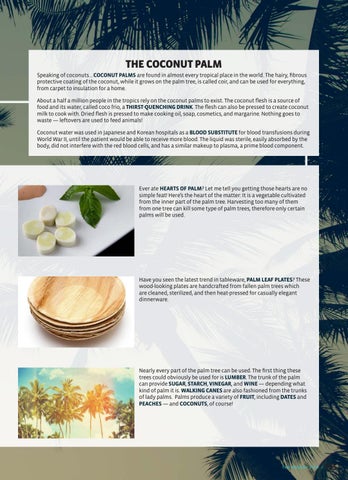THE COCONUT PALM Speaking of coconuts… COCONUT PALMS are found in almost every tropical place in the world. The hairy, fibrous protective coating of the coconut, while it grows on the palm tree, is called coir, and can be used for everything, from carpet to insulation for a home. About a half a million people in the tropics rely on the coconut palms to exist. The coconut flesh is a source of food and its water, called coco frio, a THIRST-QUENCHING DRINK. The flesh can also be pressed to create coconut milk to cook with. Dried flesh is pressed to make cooking oil, soap, cosmetics, and margarine. Nothing goes to waste — leftovers are used to feed animals! Coconut water was used in Japanese and Korean hospitals as a BLOOD SUBSTITUTE for blood transfusions during World War II, until the patient would be able to receive more blood. The liquid was sterile, easily absorbed by the body, did not interfere with the red blood cells, and has a similar makeup to plasma, a prime blood component.
Ever ate HEARTS OF PALM? Let me tell you getting those hearts are no simple feat! Here’s the heart of the matter: It is a vegetable cultivated from the inner part of the palm tree. Harvesting too many of them from one tree can kill some type of palm trees, therefore only certain palms will be used.
Have you seen the latest trend in tableware, PALM LEAF PLATES? These wood-looking plates are handcrafted from fallen palm trees which are cleaned, sterilized, and then heat-pressed for casually elegant dinnerware.
Nearly every part of the palm tree can be used. The first thing these trees could obviously be used for is LUMBER. The trunk of the palm can provide SUGAR, STARCH, VINEGAR, and WINE — depending what kind of palm it is. WALKING CANES are also fashioned from the trunks of lady palms. Palms produce a variety of FRUIT, including DATES and PEACHES — and COCONUTS, of course!
T H E M O N SE Y VIE W /
125
